Search results 14 Found
Tales of Mystery & Imagination.
Tales of Mystery & Imagination.
POE, Edgar Allan. SHARP, William (illus.) STARRETT, Vincent.
- Publisher: Printed for the Members of the Limited Editions Clun at The Garamond Press, Baltimore
- Date published: 1941
- Format: Hardcover
Preface by Vincent Starrett. xxiv, 476 [1] pp. With 16 Aquatints by William Sharp. Large 8vo, publisher's boards lettered in silver; all edges marbled; lacking slipcase. First of this edition; No, 982 of 1500 copies, signed by William Sharp. Some light staining as though from clear tape on the endsheets front and rear; small (blank) corner torn from a preliminary leaf; lettering on spine partially effaced; tiny areas of rubbing at extremities.
jeffreyhmarksrarebooksa-35.00-d227757c565552151b51fd4c2d5a4da9
Tales of Mystery and Imagination
Tales of Mystery and Imagination
Poe, Edgar Allen; Poe, Edgar Allan
- Publisher: Creative Editions
- Date published: 1996
- Format: Hardcover
- ISBN: 9780151002344
Signed. First Edition. SIGNED by Gary Kelley.
booksfromcalifornia-60.00-61a54862d7ba1c905df5ccce7149f983
Tales of Mystery and Imagination (signed)

Tales of Mystery and Imagination (signed)
Poe, Edgar Allan
- Publisher: Creative Editions, Mankato
- Date published: 1996
- Format: Hardcover
- ISBN: 9780151002344
1st ptg., large 4to, cloth backed boards, illustrated by Gary Kelley in color, three classic tales: "The Black Cat," "The Fall of the House of Usher," and "The Cask of the Amontillado." Fine in fine, unclipped dj, signed by Kelley on front free endpaper. Signed by the artist.
budplanthutchisonbooks-60.00-5b6873dfef5cdddeecbcc2c1685be43b
Tales of Mystery & Imagination
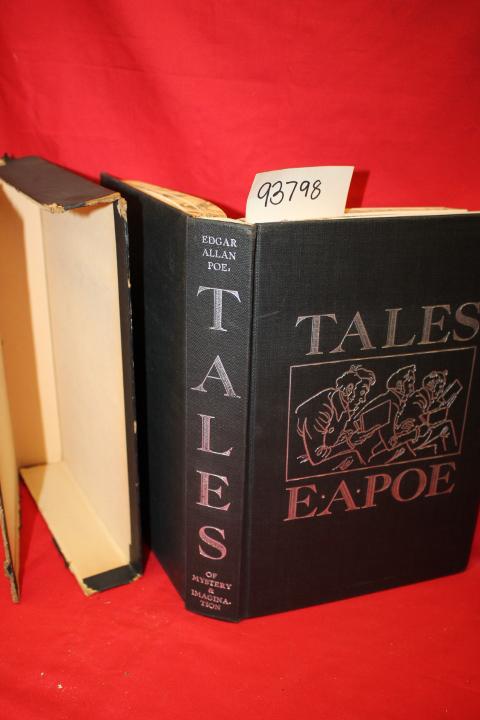
Tales of Mystery & Imagination
Poe, Edgar Allan : sharp, william
- Publisher: GARAMOND LIMITED EDITIONS, BALTIMORE
- Date published: 1941
- Format: Hardcover
Very slightly worn corners.No markings. Clean pages.Black and white illustrations.Comes with a heavily damaged black slip case. Contains 16 Aquatints by William Sharp as well as a preface by Vincent Starrett. "This book has been made for the members of the Limited Editions Club and there are therefore fifteen hundred copies. The illustrations are original aquatints drawn on the plates by William Sharp, and the prints have been made by Charles Furth. The book has been printed at the Garamond Press in Baltimore,where Edgar Allan Poe sold his first tale. The paper was supplied by the worthy paper company; and the binding done by the Russell-Ruther Company. This copy is number 774 and it is signed by William Sharp." DATE PUBLISHED: 1941 EDITION: 476+
princetonantiquesbookshop-200.00-cd92739cbba1cab1c7eb95af20113d44
Tales of Mystery and Imagination Everyman's Library edited by Ernest Rhys with an Introduction by PÃ draic Colum
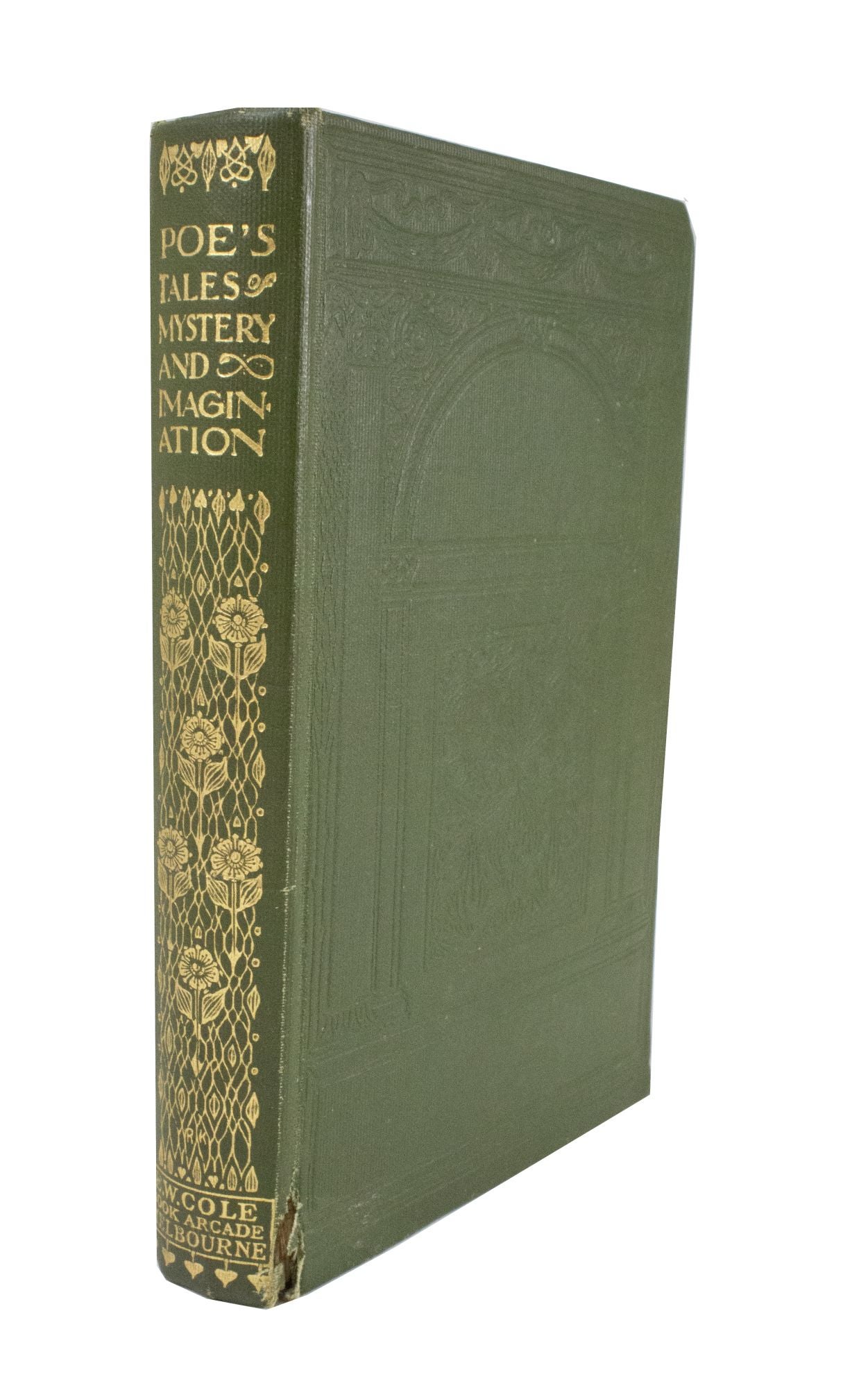
Tales of Mystery and Imagination Everyman's Library edited by Ernest Rhys with an Introduction by PÃ draic Colum
POE, Edgar Allan
- Publisher: E. W. Cole, Melbourne
- Date published: 1910
- Format: Hardcover
Small octavo, original green cloth with gilt spine lettering and embossed illustration on front cover, illustrated free endpapers, xv, 518 pp. Localised tear at spine tail, signed 'John Monash 1914', localised insect bites visible at bottom left corner of front endpaper, some foxing on preliminary leaves, otherwise a very good copy. 'John Monash 1914' dated signature on decorated front endpaper. Edgar Allan Poe's Tales of Mystery and Imagination is a compilation of writings published posthumously. In 1908, Irish poet and novelist, Padraic Colum (1881-1972), selected forty-five tales from Poe's collection to form a new version of Edgar Allan Poe's Tales of Mystery and Imagination. A first posthumous collection of Poe's work was compiled and published in 1850. It was only in 1902 that the title Tales of Mystery and Imagination was used for the first time in England by The World's Classics. Poe's command of language and technique, his imagination, and his use of horror and mystery enabled him to become an influential figure in the American literary world and abroad. He played a significant role in the readers' growing interest in Gothic fiction which had sprung from the Romanticism movement of the late eighteenth-century with English authors such as Ann Radcliffe (1764-1823) and established short stories as a serious literary form. Poe's Tales of Mystery and Imagination is composed of stories of revenge and murders like 'The Cask of Amontillado', haunted house tales like the well-known 'The Fall of the House of Usher', and one of the first detective stories in fiction 'The Murders in the Rue Morgue'. This copy of Poe's Tales of Mystery and Imagination belonged to Sir John Monash (27 June 1865- 8 October 1931) - Commander of the Australian Corps during World War One and civil engineer - as indicated by the signature on the front endpaper. Sir John Monash was commander of the 4th Infantry Brigade during the Gallipoli campaign. In July 1916, he was promoted Major General and commanded the Australian 3rd Division around Ploegsteert. Being of Prussian-Jewish descent, his rise within the army wasn't without contention but, in 1918, he obtained the rank of Lieutenant General and commanded the Australian Corps. After World War One, Monash accepted the appointment as Director-General of Repatriation and Demobilisation and carried out the repatriation of Australian troops from Europe.
rareaviationbooks-514.79-919bd49fe29d0b23ed7c1911282ce39e
Tales of Mystery and Imagination plus Special Edition of The Raven [Folio Society Limited Edition]

Tales of Mystery and Imagination plus Special Edition of The Raven [Folio Society Limited Edition]
Poe, Edgar Allan; Gallagher, Evangeline (Illustrated by); Hill, Joe (Introduced by)
- Publisher: Folio Society, London
- Date published: 2024
- Format: Hardcover
A new and unopened copy, as received directly from The Folio Society. Stock images. 'Tales of Mystery and Imagination' is strictly limited to 500 hand-numbered copies which sold out in under 7 hours at The Folio Society. This stunning Folio Society limited edition commemorates the death of Edgar Allan Poe - the undisputed master of the American Gothic short story - who died in mysterious circumstances on 7 October 1849. It celebrates a legacy that has infused so much of our literary world. To invoke this legacy, Folio's new edition features an exclusive new introduction by award-winning horror writer, Joe Hill. Quarter bound in goatskin with cloth sides blocked in 2 foils with a design by the artist, this stunning limited edition is illustrated by the Folio Book Illustration Award winner, Evangeline Gallagher with 10 full page integrated illustrations and 24 motifs and vignette along with a coloured frontispiece. It is printed in two colours on Munken Pure paper, has decorated page edges, and a ribbon marker. A fitting tribute to Edgar Allan Poe and his tales, this edition is encased in a box featuring a human ribcage which opens out to reveal a bloody heart on the cover of the book. There is a letterpress-printed limitation tip signed by Joe Hill and Evangeline Gallagher, This edition is accompanied by a separate publication of Poe's most famous poem, 'The Raven', printed using hot-metal setting by Nomad Letterpress and hand-sewn using red thread and black Twist paper covers. This is a new copy which will be shipped in the original FS packaging and an outer box for additional protection. HEAVY/OVERSIZE/HIGH VALUE. U.K. postage at default charge but overseas buyers may be asked for extra. Enquiries welcome. U.S. BUYERS: Books remain exempt from import duty under U.S. law. I provide accurate customs forms to protect buyers from unnecessary charges and to minimise delays. All orders professionally packed, tracked and/or signed for, and insured.
bathwestbooks-1009.89-ac76ded2a36a0a4460c4dc5b22dff2a0
Tales of Mystery and Imagination

Tales of Mystery and Imagination
Edgar Allan Poe (introduction by Joe Hill)
- Publisher: Folio society, London
- Date published: 2024
- Format: Hardcover
Signed Limited Edition of 500 copies, this copy No.461. Signed by both Evangeline Gallagher and Joe Hill. 4to, xvii + pp386 with evocative illustrations by Evangeline Gallagher throughout plus a separate letterpress booklet of 'The Raven' pp25. Hardcover in slipcase. Front opening slipcase of rib cage with magnetic strip for easy closure, in fine/new condition. Beautifully bound in quarter black goatskin over decorated boards in fine/new condition. Inside all pages and illustrations in fine/new condition. This limited edition commemorates the death of Poe and celebrates a legacy that has infused so much of our literary world. From swinging pendulums, beating hearts and malevolent cats to the first true detective stories (featuring C. Auguste Dupin), Poe's works of the macabre continue to inspire and influence writers. A superb copy still in original wrappings and box. This Limited Edition sold out within 24 hours.
nikkigreenbooks-2033.33-1b020c4b911536b2d4afd4c55b603cc4
Tales of Mystery and Imagination. By Edgar Allan Poe. Illustrated by Arthur Rackham

Tales of Mystery and Imagination. By Edgar Allan Poe. Illustrated by Arthur Rackham
RACKHAM, Arthur]. POE, Edgar Allan
- Publisher: Harrap
- Date published: 1935
- Format: Hardcover
12 tipped in color plates. one of 460 numbered copies, signed by RACKHAM!!!! A Beautiful copy. A fine first in vellum with gold decorations to covers. SPECTACULAR ILLUSTRATIONS! Original vellum over boards pictorially stamped and lettered in gilt on front cover and spine. Top edge gilt, others uncut. Black and white pictorial endpapers. Twelve mounted colour plates, w ith descriptive tissue guards, seventeen black and white plates, and eleven small drawings in black and white. Signed by the RACKHAM. Without original slipcase. But very rare in this condition.
vagabondbooks-3500.00-85ae86a40af2bbd835b1db8389168079
Tales of Mystery and Imagination, by Edgar Allan Poe. Illustrated by Arthur Rackham
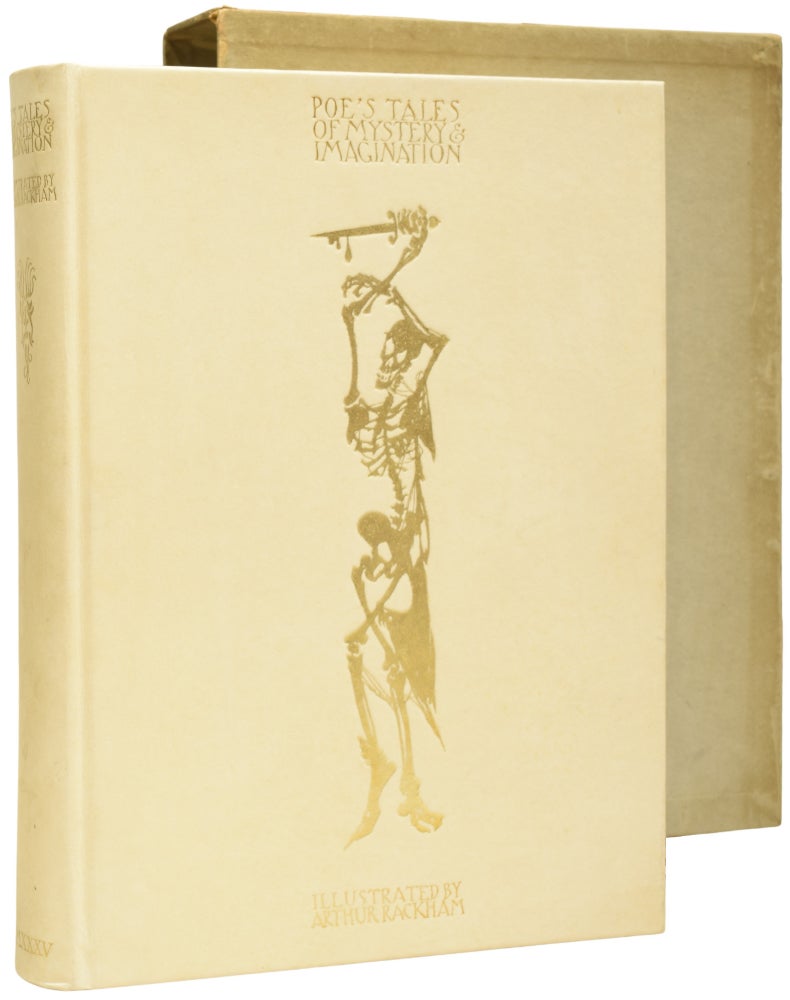
Tales of Mystery and Imagination, by Edgar Allan Poe. Illustrated by Arthur Rackham
POE, Edgar Allan (1809-1849), [RACKHAM, Arthur, illustrator]
- Publisher: London: George G. Harrap & Co., Ltd., 1935
- Date published: 1935
- Format: Hardcover
[Illustrated Strange Tales] SIGNED LIMITED EDITION. Large octavo (28 x 21cm), pp.[2] 318 [2]. With 12 fine colour plates, each with a captioned tissue guard, and 17 line drawings, all by Rackham. Number 329 of 460 copies thus, SIGNED by the illustrator in black ink to the limitation page. Publisher's deluxe full vegetable parchment, with gilt titles and decoration to spine and upper. Top edge gilt; others untrimmed, with black and white illustrated endpapers. With the original publisher's card slipcase, with a printed paper title label to spine. Internally crisp and clean. Bright binding shows minimal spotting, and a hint of toning to spine. Moderate general wear and toning to slipcase. Near fine. A seminal figure in the development of science fiction and the detective story, Edgar Allan Poe (1809-1849) exerted a great influence on Dostoyevsky, Conan Doyle, Verne, and Baudelaire. This collection of Poe's best stories contains all the terrifying and bewildering tales that characterise his work, as well as the Gothic horror of 'The Pit and the Pendulum', together with all three of the landmark cases featuring his ground-breaking detective Auguste Dupin. The history of the detective story begins with the publication of 'The Murders In the Rue Morgue' (Matthews).
adrianharringtonpbfa-3727.80-c660d29a153b17f4d4e46c1c73a78fb9
Tales of Mystery and Imagination
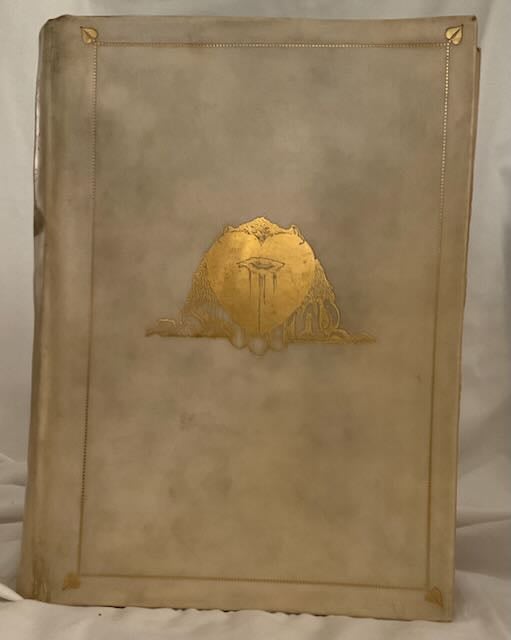
Tales of Mystery and Imagination
Poe, Edgar Allan
- Publisher: Harrap, London
- Date published: 1919
- Format: Hardcover
#151 of 170 copies signed and numbered by Harry Clarke. 4to full vellum, 24 full page black and white plates with tissue guards. This was before the color plates were added to later editionsthis is the only signed limited of all the editions. Quite scarce today. Gilt spine titles and small gilt illustration on the front cover, bordered by a design of chains & hearts all in gilt. Top edge gilt. The vellum is separating from boards at top of pastedown endpapers, very slightly in front, about 2 1/2 inches in rear. Modest bowing to boards and a little unevenness to the spine. Modest darkening to covers. Without previous ownership markings. No foxing, interior pages very clean. A solid copy of the scarcest of all Clarke titles and the most reprinted of them all, proving its popularity over the last 100 years. Signed by Clarke.
budplanthutchisonbooks-4000.00-550ead698e298bde79479b6a929215cb
Poe's Tales of Mystery and Imagination
Poe's Tales of Mystery and Imagination
Edgar Allan Poe (Rackham, Arthur)
- Publisher: George C. Harrap
- Date published: 1935
- Format: Hardcover
First Edition. A sharp copy of this limited edition of 460 copies SIGNED by Arthur Rackham. The book is in nice shape. The binding is tight, and the boards are crisp with light wear to the spine and edges. The pages are clean with no writing, marks or bookplates in the book. Overall, a lovely copy SIGNED by Rackham in collector's condition. We buy SIGNED Rackham books.
magnumopusrarebooks-4500.00-25316b3e2f6ff50f19ce85b1c733786c
TALES OF MYSTERY AND IMAGINATION

TALES OF MYSTERY AND IMAGINATION
POE, Edgar Allan
- Publisher: HARRAP, George G., LONDON
- Date published: 1935
- Format: Hardcover
Very Fine. A beautiful, finely bound literary treasure. Titles and box design to spine gilt, titles and pictorial decoration to front board gilt, inner dentelles gilt, marbled endpapers, top edge gilt, others untrimmed. Twelve fine color plates and seventeen line drawings, captioned tissues. SIGNED on the limitation page by Arthur Rackham. A truly Fine copy. SIGNED LIMITED EDITION OF 460 COPIES, THIS BEING NUMBER 168.
mysterypierbooks-5000.00-550ead698e298bde79479b6a929215cb
Tales of Mystery and Imagination. Illustrated By Harry Clarke
Tales of Mystery and Imagination. Illustrated By Harry Clarke
POE, Edgar Allan
- Publisher: George G. Harrap & Co. Ltd, London
- Date published: 1919
Stout Quarto. Limited deluxe edition of only 170 copies, signed and numbered on the limitation page by Harry Clarke, this being #12. 24 full-page halftone illustrations with tissue guards, plus head and tail pieces. 382 pages bound in full vellum with bright gilt decoration to cover, gilt spine lettering, top edge gilt, others deckled. A magnificent, collectible copy with interior exceptionally clean and crisp, and with the vellum clean and unmarked. A beautiful, fresh copy of a scarce item.
karolkrysikbookscpbfa-5868.94-5a35a532378bf2593fcdf429e160a361
TALES OF MYSTERY & IMAGINATION
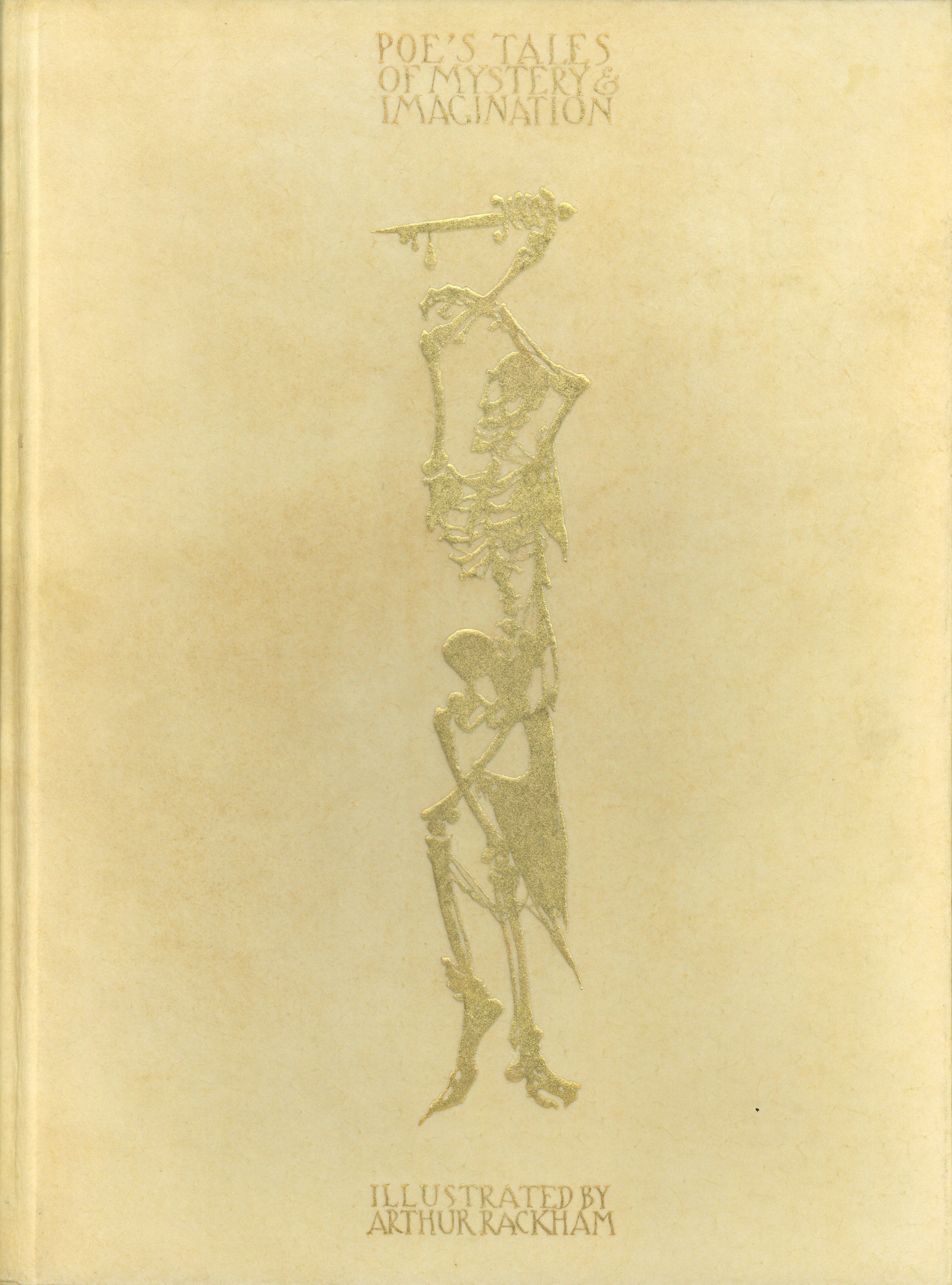
TALES OF MYSTERY & IMAGINATION
Poe, Edgar Allan
- Publisher: George G. Harrap & Co., Ltd., London
- Date published: 1935
- Format: Hardcover
(Rackham, Arthur) illustrator. TALES OF MYSTERY & IMAGINATION by Edgar Allan Poe; illustrated by Arthur Rackham. London: George G. Harrap & Co., Ltd., 1935. FIRST RACKHAM EDITION; "Edition limited to Four Hundred and Sixty copies, of which Four Hundred and Fifty are for sale. This is copy No. 191;" signed by Arthur Rackham on the limitation page. 4to - 10-11/16" x 8". Publisher's deluxe full vellum covered boards with titles and decoration stamped in gilt to front cover and spine with an ever so slightly toned spine for what is a stunning copy of the book. Original publisher's gray paper covered board slipcase with paper label printed in brown pasted to spine with hand-inked number matching the book's number with wear to the edges but completely intact and still quite nice. Black and white pictorial endpapers designed by Rackham; bookplate of Walter S. Carpenter, Jr. on front pastedown. t.e.g.; others uncut; some pages unopened. 317, [1] pp., plus 12 unnumbered leaves of colored plates and 17 unnumbered leaves of black and white plates. Twenty-five different tales by Edgar Allan Poe, illustrated by Arthur Rackham with color frontispiece and eleven additional color plates, all with captioned tissue guards, plus seventeen black and white plates and numerous black and white drawings and vignettes within text; internally the book is fine. The condition of the book is FINE. The condition of the slipcase is VERY GOOD. Latimore and Haskell, pp. 72-73; Riall, p. 189.
wallaceclarkbooksellers-6750.00-55ccf64b5b7c8ff52d4e491735368d4b
